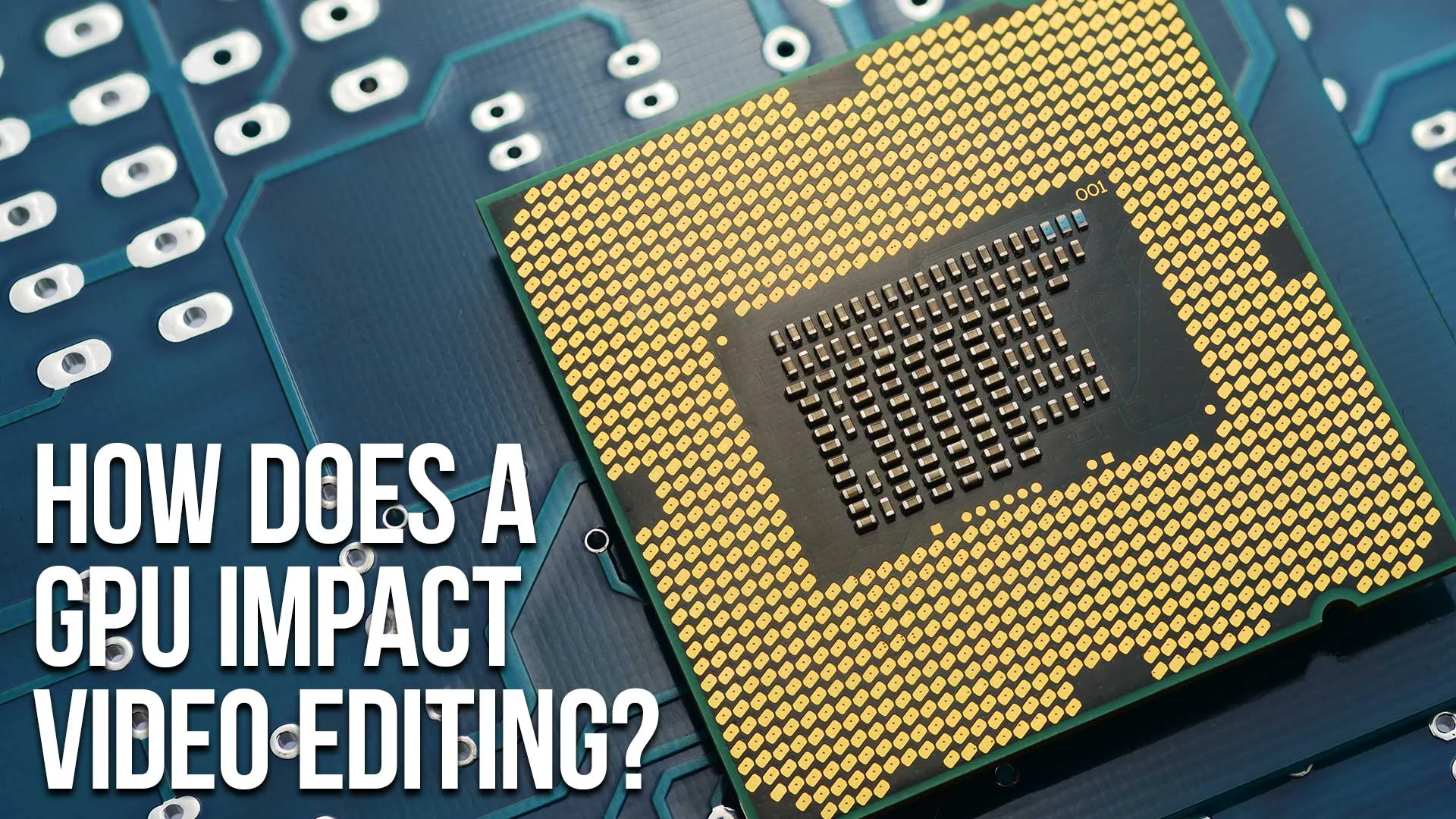The main way that a GPU impacts video editing is by reducing render times.
Render times refer to the amount of time it takes for your computer to process and output the final version of your video project.
Video editors often want the best Mac they can afford for video editing, and the GPU is part of that equation.
If you have a powerful GPU, your render times will be shorter because your computer will be able to process the graphics more quickly.1234.
This is particularly important if you are working with 4K or 8K video, which both require more processing power than lower resolutions.
What are the Current GPUs Available in Macs?
The current line of Mac laptops includes:
MacBook Air (M1 processor), with a 7-core GPU on the M1 Chip
MacBook Air (M2 processor), with an up-to-10-core GPU on the M2 Chip
MacBook Pro 13" (M2 processor), with an up-to-10-core GPU on the M2 Chip
MacBook Pro 14" (M1 Pro processor or M1 Max Processor), with an up-to-32-core GPU on the M1 Max Chip
MacBook Pro 16" (M1 Pro processor or M1 Max Processor), with an up-to-32-core GPU on the M1 Pro Chip
iMac 24" (M1 processor), with an up-to-8-core GPU on the M1
Mac mini (M1 processor), with an 8-core GPU on the M1
Mac Studio (M1 Max or M1 Ultra Processor), with an up to 64-core GPU on the M1 Ultra
Mac Pro (Intel Xeon W processor), with a Radeon Pro W6800X Duo GPU
As you can see, the newest Macs have significantly higher GPU capabilities than older models. If you are a serious video editor, it may be worth considering upgrading to one of these newer laptops for improved render times and overall performance.
Which Mac do I Use?
My daily driver Mac is a 2021 MacBook Pro with an Apple M1 Max processor and a 32-core GPU.
I usually spend money on the GPU because I do a lot of work in Adobe After Effects and also do professional color grading in DaVinci Resolve, both of which benefit from a fast GPU.
Which Video Editing Apps Use the GPU?
Final Cut Pro
(GPU more than CPU)
Apple's Final Cut Pro relies heavily on the system's GPU.
The program allows you to choose whether you want it to prioritize CPU or GPU when rendering, but using the GPU will generally result in faster render times.

Adobe Premiere Pro
(CPU more than GPU)
Adobe Premiere Pro also utilizes the GPU for certain tasks, such as rendering and exporting video.
However, it may not always use the full capabilities of the GPU, so it may not result in significant speed improvements for every project.
DaVinci Resolve
(GPU more than CPU)
DaVinci Resolve utilizes the GPU for tasks such as playback and rendering, but it also allows you to use both the CPU and GPU simultaneously for even faster render times.

Avid Media Composer
(CPU more than GPU)
Avid Media Composer utilizes the GPU for certain tasks, such as effects and color correction. However, it may not always use the full capabilities of the GPU, so it may not result in significant speed improvements for every project.
Overall, having a powerful GPU in your Mac can greatly improve your video editing experience by reducing render times.

GPU Frequently Asked Questions
What is a GPU? How is it different from a CPU?
A GPU is a type of computer processor designed specifically to handle graphics-intensive tasks, such as video rendering and gaming. It is different from a CPU (central processing unit), which handles more general computing tasks.
Can I upgrade my Mac's GPU?
In most cases, no. The GPU is typically integrated into the computer's main processor (such as the M1 chip in newer Macs), so it cannot be replaced or upgraded separately. However, you can still improve your graphics performance by upgrading to a newer Mac with a more powerful integrated GPU.
Do all video editing apps use the GPU?
No, not all video editing apps utilize the GPU for tasks such as rendering. It is important to check the system requirements and capabilities of a specific program before purchasing it or upgrading your computer.
Do all computers have a GPU?
No, not all computers have a dedicated GPU. Some may only have integrated graphics, which use the CPU to handle graphics tasks. These may not be suitable for high-end graphics tasks such as gaming and video editing. It is important to check the specifications of a computer before purchasing it if you plan on using it for graphics-intensive tasks.
What is VRAM?
VRAM, or video RAM, is a type of memory used by the GPU to store graphics and visual data. More VRAM can improve performance for graphics-intensive tasks, such as gaming and video editing. However, it is important to note that having a high amount of VRAM does not always guarantee better performance – it also depends on the overall capabilities of the GPU itself.
What are GPU Cores?
GPU cores, also known as stream processors or CUDA cores (on NVIDIA GPUs), are units within a GPU that handle computing tasks. More GPU cores can improve performance for graphics-intensive tasks, but it is important to note that overall GPU capabilities (such as architecture and clock speed) also play a role in performance.
Can my computer's GPU affect battery life?
Yes, a more powerful GPU may require more power and therefore hurt battery life. It is important to consider both performance and battery life when choosing a laptop for graphics-intensive tasks.
Do I Need a Fast GPU for Video Editing?
It depends on the specific video editing program and the resolution and complexity of your project. In general, a more powerful GPU can improve performance for graphics-intensive tasks such as rendering, but it may not always be necessary for every project.
It is important to check the system requirements and capabilities of your chosen video editing program before upgrading your computer or purchasing new software.
However, investing in a more powerful GPU can future-proof your computer and make it better equipped to handle complex projects in the future.
Do Macs have better GPUs than PCs?
This is not necessarily true. Both Macs and PCs offer a range of different GPUs with varying levels of power and performance. It is important to consider the specific specs and capabilities of a particular computer or GPU, rather than simply comparing Macs and PCs as a whole.
Additionally, some video editing programs may have better compatibility with certain GPUs or operating systems. So it is important to also factor in your preferred software when making a decision about which computer to use for graphics-intensive tasks.
The current M-series of chips from Apple, though, are about as fast as any PC GPUs on the market, and often use less power for the same amount of compute power on a PC GPU.
Can a GPU be used for tasks other than graphics?
Yes, GPUs can also be utilized for non-graphics-related computing tasks, such as scientific calculations and machine learning. This is known as GPGPU (General Purpose Computing on Graphics Processing Units) computing.
However, not all GPUs are suitable for GPGPU computing, and it is important to check the capabilities of a specific GPU before utilizing it for these tasks.
Additionally, CPUs may still be more efficient for some non-graphics-related tasks. So it is important to consider both the capabilities of the GPU and the specific requirements of the task before using a GPU for non-graphics related computing.
What is a GPU's Neural Engine?
A GPU's Neural Engine is a dedicated processing unit specifically designed for artificial intelligence and machine learning tasks. Having a powerful Neural Engine can improve performance for these types of tasks.
However, it is important to note that the overall capabilities and architecture of the GPU also play a role in its performance for AI and machine learning tasks.
What is the Fastest Mac GPU currently?
The current fastest Mac GPU is the 64-core GPU on the M1 Ultra, available in the Mac Studio as a build-to-order option.
Before the M1 and M2 chips, the fastest Mac GPU was the Radeon Pro Vega 64, which was available in the Intel 16-inch MacBook Pro. This GPU offers up to 11 teraflops of single precision and 22 teraflops of half precision computation power.
Conclusion:
As a video editor, it's important to have a powerful graphics processing unit (GPU) in your Mac so that you can reduce render times and work efficiently.
There are many different GPUs available on the market today, so be sure to do your research before buying one for your computer.
And remember, not all video editing applications use the GPU equally—3D applications generally require more power than 2D ones—but all will see some benefit from having a powerful GPU in your system.

About the Author
Joseph Nilo has been working professionally in all aspects of audio and video production for over twenty years. His day-to-day work finds him working as a video editor, 2D and 3D motion graphics designer, voiceover artist and audio engineer, and colorist for corporate projects and feature films.
Video Editing Related Posts
Adobe Creative Cloud for Video Editing
Top 10 Video Editing Software for Mac
The Benefits of Dual-Monitor Setups for Video Editing
How to Choose the Right Video Editing Monitor for Your Needs
Best Monitors for Video Editing
Best Video Editing Software in 2023
Best Mac for Video Editing in 2023
(Almost) 50 Mistakes Every New Video Producer Makes
Breakthrough AI Tools: Elevate Your Video Production Game!
- What Are The Current Gpus Available In Macs?
- Which Video Editing Apps Use The GPU?
- Final Cut Pro
- Adobe Premiere Pro
- Davinci Resolve
- Avid Media Composer
- GPU FAQ
Video Editing Related Posts
Adobe Creative Cloud for Video Editing
Top 10 Video Editing Software for Mac
The Benefits of Dual-Monitor Setups for Video Editing
How to Choose the Right Video Editing Monitor for Your Needs
Best Monitors for Video Editing
Best Video Editing Software in 2023
Best Mac for Video Editing in 2023
(Almost) 50 Mistakes Every New Video Producer Makes
Breakthrough AI Tools: Elevate Your Video Production Game!
